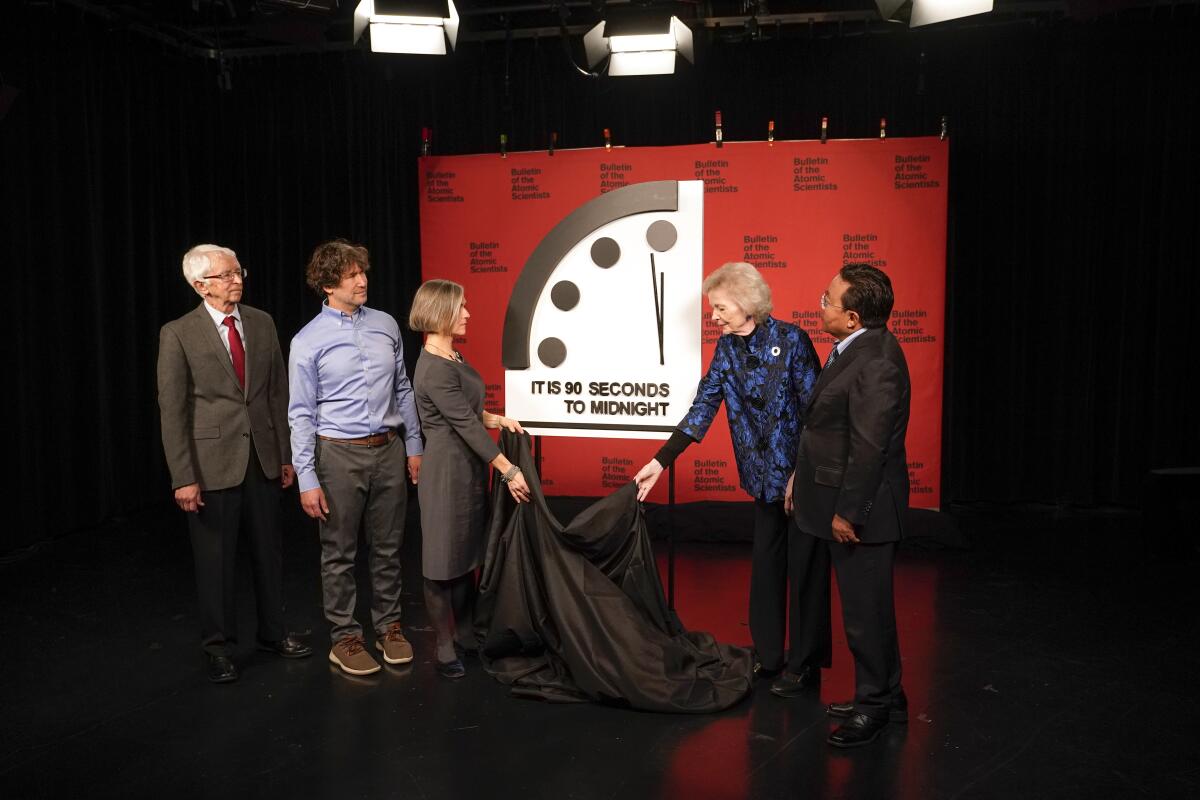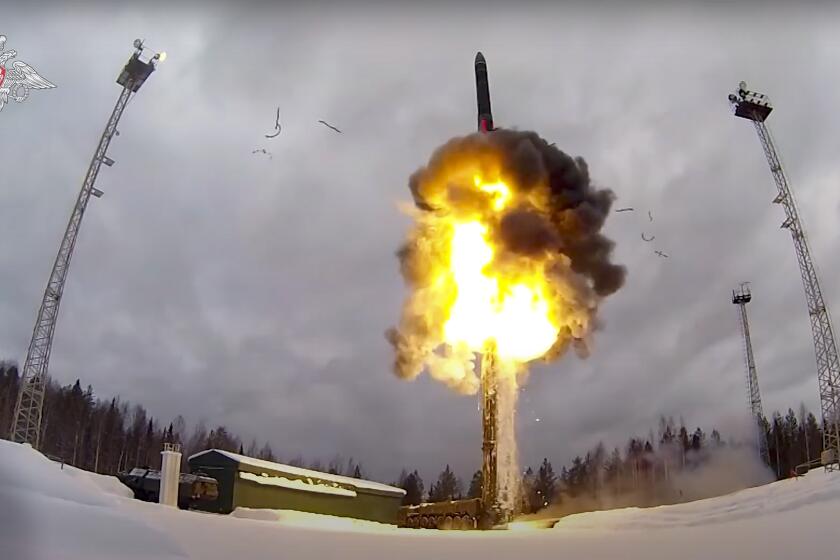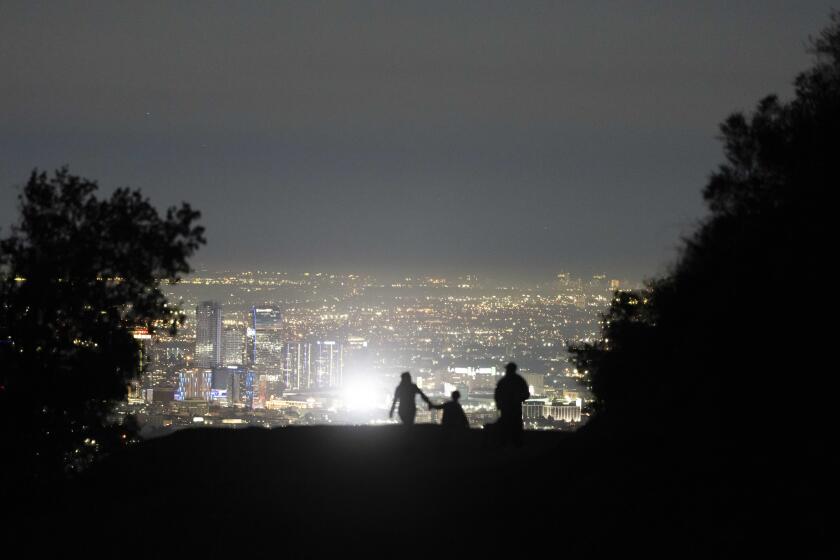Opinion: Nuclear threats? Climate change? What catastrophe will lead to doomsday?

- Share via
If you needed a reminder that all is not well with the world, the Doomsday Clock moved forward once again in January. It’s now set for 90 seconds until midnight — closer to doom than ever before.
The last time it changed was in 2020, when the Bulletin of the Atomic Scientists — which created the clock in 1947 — jumped it forward 20 seconds. The group attributed this year’s time shift mostly to Russia’s war in Ukraine, now almost at its one-year mark. They also cite concerns relating to climate change, biological threats and disruptive cybertechnologies.
The war in Ukraine has clearly brought fears of a large-scale nuclear war back to the forefront. Neither Russia, the U.S. nor NATO is eager for nuclear destruction, but the history of nuclear weapons is full of reminders that miscalculation and accidents — to say nothing of newer threats like misinformation and cyberattacks — could lead to brushes with annihilation.
The dangerous idea of possessing or even using nuclear weapons is fading with the emergence of a new generation of so-called tactical nuclear weapons.
The Doomsday Clock is, of course, a subjective measure of current risk. It was never meant to be a scientific instrument. In the last 10 years, it has marched closer to midnight five times, and it retreated just once since 1991. That might sound pessimistic. But let’s be honest: The 21st century hasn’t exactly felt like it is trending in the right direction.
The Bulletin was founded in late 1945 by scientists who were connected to the invention of the atomic bomb. They believed that once mushroom clouds rose over Hiroshima and Nagasaki, scientists could no longer be disengaged from the world of politics. The Bulletin aimed to draw scientists into discussions about their responsibilities in dealing with the new problems created by nuclear technology, and to make sure the public had independent, expert assessments of these new threats.
But it took a few years more for the publication to become an official doomsayer. The Doomsday Clock’s original design and setting, seven minutes to midnight, were purely aesthetic choices. Only in 1949, when its clock hands were moved for the first time following the Soviet Union’s first atomic bomb test, did it start being understood as some kind of measurement of existential risk. In its early years, the Bulletin’s founding editor in chief, physicist Eugene Rabinowitch, determined all of the clock’s changes. After his death in 1973, the changes were handled by the Bulletin’s board of directors and, as of 2008, by a science and security board composed of experts.
That year, the Bulletin expanded the clock’s symbolism — from almost exclusively a measure of nuclear risk to encompassing other existential threats, particularly climate change, as well as biological and cyberthreats.
That decision was understandable, since concerns over nuclear war were being eclipsed by growing awareness of climate change — with more extreme weather events, intensifying droughts, migration pressures and disease risks. But the nuclear threat didn’t go away, as we’ve seen again and again since then.
We can apply lessons from tackling another existential problem to the climate crisis.
The changes to what the Doomsday Clock measures also highlight the symbol’s biggest problem. “Midnight” implies a finality: the end-of-the-world hard stop that we associate with nuclear war. But even nuclear war wouldn’t be quite so abrupt; there would be a lot of survivors, even in the nations that were directly attacked, and they would have to deal with whatever came next. As catastrophic as nuclear strikes could be, they wouldn’t be the end of history. The tragic stories we read of Hiroshima are not of the people who died immediately, but of survivors who had to rebuild their lives, city and nation.
Climate change is a different kind of risk altogether. There won’t be some single abrupt event that ends the world. It’s what scholars call a “slow disaster,” something that will unfold over decades, even centuries. It’ll just be a world that gets harder to live in, with devastating local disasters, worsening weather extremes and growing systemic problems. But there will be no single Earth-killing moment. The symbol of this kind of threat isn’t a clock — it’s one of those ever-proliferating graphs that shows the temperature going upwards into new highs.
These realities may put the experts at the Bulletin in a bind: Under what conditions will they feel confident turning the clock back to announce decreasing risk? If climate change means runaway risk, at least in our lifetimes, they will eventually run out of time before tripping into “midnight.”
There is an almost comic effect of counting doomsday by ever smaller moments. If the clock starts counting in milliseconds, it might seem farcical. By then we’ll have run out of time, and the symbol won’t matter much as a warning.
Nuclear risk can seem to wax and wane very quickly: One day, things can seem good, but a week later a new crisis might rear its head. Then during a crisis, all can seem hopeless, but a year later, things might cool substantially. Climate change, conversely, offers neither a sudden threat nor the hope of quick resolution. But there are still ways in which we can slow its pace, mitigate its consequences and, over a long time, reverse its trends.
The Doomsday Clock has been a potent messaging device for nuclear scares. But we’re now confronting another manmade form of annihilation that might well need a new kind of symbol. Whether these symbols will be enough to motivate real action is, ultimately, up to us.
Alex Wellerstein is a historian of nuclear weapons at the Stevens Institute of Technology, the author of “Restricted Data: The History of Nuclear Secrecy in the United States” and the creator of the Nukemap online nuclear weapons simulator.
More to Read
A cure for the common opinion
Get thought-provoking perspectives with our weekly newsletter.
You may occasionally receive promotional content from the Los Angeles Times.












